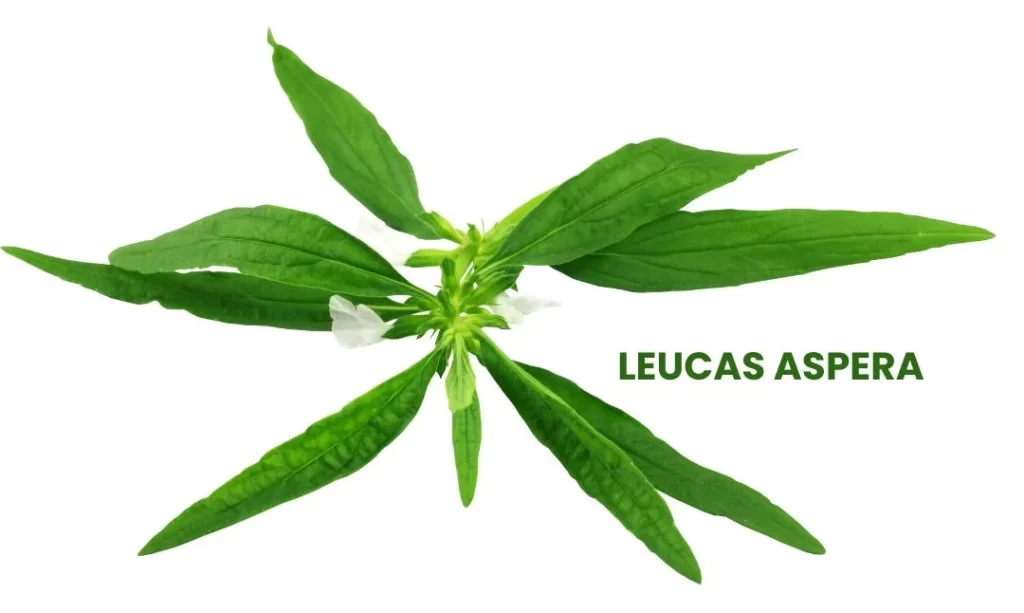Leucas Aspera, commonly known as Drona or Dronapushpi, is a medicinal herb belonging to the family Labiatae.
It is widely known for its therapeutic properties and has been used in traditional medicine to treat a variety of ailments, including intermittent fever, asthma, cough, dysentery, jaundice, and the bites of venomous animals.
This plant is also effective in treating skin troubles and has been noted for its remarkable efficacy in treating snake and scorpion bites.

Table of Contents
ToggleSOURCE INFORMATION
Scientific Classification
- Kingdom: Plantae
- Clade: Angiosperms
- Clade: Eudicots
- Order: Lamiales
- Family: Lamiaceae (Labiatae)
- Genus: Leucas
- Species: L. aspera
Origin and Historical Facts
Leucas Aspera is native to tropical and subtropical regions of Asia and Africa.
It grows in various habitats, including grasslands, fields, and forest edges.
Historically, this plant has been mentioned in ancient texts of Ayurveda and traditional medicine for its diverse medicinal properties.
Indigenous communities have utilized this herb extensively to treat common ailments and emergency situations, especially for bites from venomous animals like snakes and scorpions.
- Geographic Distribution: Found widely across India, Sri Lanka, Myanmar, and other tropical regions of Asia and Africa.
- Active Constituents: Contains essential oils, alkaloids, flavonoids, and terpenoids which contribute to its medicinal properties.
- Pharmacological Properties: Antipyretic, anti-inflammatory, analgesic, bronchodilator, and antimicrobial.
DRUG PATHOGENESIS
Leucas Aspera primarily affects the respiratory system, gastrointestinal system, skin, and urinary system.
It has notable anti-inflammatory and analgesic properties, making it effective in treating conditions that involve inflammation and pain.
KEY CHARACTERISTICS
- Effective in treating intermittent fevers, often used in traditional remedies for malarial and other recurrent fevers.
- Provides relief from asthma and persistent cough by acting as a bronchodilator and expectorant.
- Treats dysentery and jaundice, helping to improve liver function.
- Known for its efficacy in treating bites from venomous animals, especially snakes and scorpions.
DETAILED ORGAN SYMPTOMS
RESPIRATORY SYSTEM
- Asthma and Cough: Provides relief by dilating the bronchi and easing breathing difficulties. It also helps expel mucus from the respiratory tract.
- Bronchitis and Pneumonia: Effective in managing inflammation and infection of the bronchi and lungs, reducing symptoms like coughing and difficulty in breathing.
GASTROINTESTINAL SYSTEM
- Dysentery and Jaundice: Helps treat dysentery with its antimicrobial properties.
- Also improves liver function, reducing jaundice symptoms.
- Enlargement of Liver and Spleen: Reduces swelling and improves the overall function of these organs, often related to chronic infections.
SKIN
- Skin Troubles: Relieves itching, inflammation, and other skin conditions.
- Particularly effective when symptoms worsen due to heat and improve with cold applications.
- Venomous Bites: The mother tincture is applied both externally and internally to treat snake and scorpion bites.
- It rapidly alleviates burning pain and other symptoms.
FEVER
- Intermittent Fever: Controls fever with associated symptoms like thirst, headache, and a burning sensation over the body. The intensity of the fever gradually decreases over time.
MODALITIES
- Worse: Heat, changes of weather.
- Better: Cold applications, cool environment.
WHAT ARE MODALITIES IN HOMOEOPATHY?
RELATIONSHIP WITH OTHER DRUGS
- Complementary: Remedies that support respiratory function and reduce fever, such as Bryonia and Belladonna.
- Similar: Remedies used for treating venomous bites and skin conditions, such as Lachesis and Apis.
DOSE
- Potency of Choice: Mother tincture, 2x, 3x.
- Snake and Scorpion Bites: Administer 10-15 drops of the mother tincture both externally and internally every 15-20 minutes until improvement.
Frequently Asked Questions
How is Leucas Aspera used in treating snake bites?
- The mother tincture is applied both externally and internally. A dose of 10-15 drops is administered every 15-20 minutes until improvement is observed.
Can Leucas Aspera be used for respiratory conditions?
- Yes, it is beneficial in treating asthma, bronchitis, and persistent cough, acting as a bronchodilator and expectorant.
What are the recommended potencies for chronic conditions?
- For chronic conditions, potencies of 2x and 3x are commonly used.
Are there any side effects of using Leucas Aspera?
- Generally well-tolerated, but excessive use may cause gastrointestinal disturbances or allergic reactions in some individuals.
Glossary of Difficult Words
- Antipyretic: A substance that reduces fever.
- Bronchodilator: A substance that dilates the bronchi and bronchioles, decreasing resistance in the respiratory airway and increasing airflow to the lungs.
- Expectorant: A medicine that promotes the secretion of sputum by the air passages, used to treat coughs.
- Antimicrobial: A substance that kills or inhibits the growth of microorganisms.
- Venomous: Capable of injecting venom by means of a bite or sting.
This comprehensive drug picture of Leucas Aspera provides detailed information on its medicinal properties, historical usage, and recommended dosages.
If you have any further questions or need additional details, feel free to ask!
